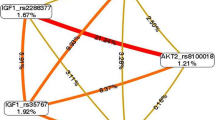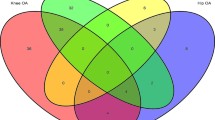Abstract
Articular cartilage is an avascular tissue with a structure that allows it to support and cushion the overload of the surfaces in contact. It maintains its metabolic functions due to the contribution of different signaling pathways. However, several factors play a role in its deterioration, allowing to the development of osteoarthritis (OA), and one of the major factors is genetic. Our goal was to identify gene–gene interactions (epistasis) between five signaling pathways involved in the articular cartilage metabolism as possible indicators of OA risk. We applied the Multifactor-Dimensionality Reduction (MDR) method to identify and characterize the epistasis between 115 SNPs located in 73 genes related to HIF-1α, Wnt/β-catenin, cartilage extracellular matrix metabolism, oxidative stress, and uric acid transporters. Ninety three patients diagnosed with primary knee OA and 150 healthy controls were included in the study. Genotyping was performed with the OpenArray system, the statistical analysis was carried out with the STATA software v14, and epistasis was analyzed with the MDR software v3.0.2. The MDR analysis revealed that the best interaction model was between polymorphisms rs17786744 of the STC1 gene and rs2615977 of the COL11A1 gene, with an entropy value of 4.44%, CVC 8/10, OR 5.60, 95% CI 3.27–9.59, p < 0.0001. Under this interaction model, we identified high and low risk genotypes involved in OA development. Our results suggest complex interactions between STC1 and COL11A1 genes that might have an impact on genetic susceptibility to develop OA. Further studies are required to confirm it.



Similar content being viewed by others
References
Sophia Fox AJ, Bedi A, Rodeo SA (2009) The basic science of articular cartilage: structure, composition, and function. Sports Health 1:461–468
Carballo CB, Nakagawa Y, Sekiya I, Rodeo SA (2017) Basic science of articular cartilage. Clin Sports Med 36:413–425
Newman AP (1998) Articular cartilage repair. Am J Sports Med 26:309–324
Chen S, Fu P, Wu H, Pei M (2017) Meniscus, articular cartilage and nucleus pulposus: a comparative review of cartilage-like tissues in anatomy, development and function. Cell Tissue Res 370:53–70
Nazempour A, Van Wie BJ (2016) Chondrocytes, mesenchymal stem cells, and their combination in articular cartilage regenerative medicine. Ann Biomed Eng 44:1325–1354
Silver IA (1975) Measurement of pH and ionic composition of pericellular sites. Philos Trans R Soc Lond B 271:261–272
Toh WS, Brittberg M, Farr J, Foldager CB, Gomoll AH, Hui JH, Richardson JB, Roberts S, Spector M (2016) Cellular senescence in aging and osteoarthritis. Acta Orthop 87:6–14. https://doi.org/10.1080/17453674.2016.1235087
Goldring MB, Marcu KB (2009) Cartilage homeostasis in health and rheumatic diseases. Arthritis Res Ther 11:324
Prieto-Alhambra D, Judge A, Javaid MK, Cooper C, Diez-Perez A, Arden NK (2014) Incidence and risk factors for clinically diagnosed knee, hip and hand osteoarthritis: influences of age, gender and osteoarthritis affecting other joints. Ann Rheum Dis 73:1659–1664
Klein JC, Keith A, Rice SJ, Shepherd C, Agarwal V, Loughlin J, Shendure J (2019) Functional testing of thousands of osteoarthritis-associated variants for regulatory activity. Nat Commun 10:2434
Zhang L, Xing R, Huang Z, Zhang N, Zhang L, Li X, Wang P (2019) Inhibition of synovial macrophage pyroptosis alleviates synovitis and fibrosis in knee osteoarthritis. Mediators Inflamm 8(2019):2165918
Blanco FJ, Möller I, Romera M, Rozadilla A, Sánchez-Lázaro JA, Rodríguez A, Gálvez J, Forés J, Monfort J, Ojeda S et al (2015) Improved prediction of knee osteoarthritis by genetic polymorphisms: the Arthrotest Study. Rheumatology 54:1236–1243
Ono M, Inkson C, Kilts T, Young M (2011) WISP-1/CCN4 regulates by enhancing BMP-2 activity. J Bone Miner Res 26:193–208
Kumarasinghe DD, Hopwood B, Kuliwaba JS, Atkins GJ, Fazzalari NL (2011) An update on primary hip osteoarthritis including altered Wnt and TGF-β associated gene expression from the bony component of the disease. Rheumatology 50:2166–2175
Chun JS, Oh H, Yang S, Park M (2008) Wnt signaling in cartilage development and degeneration. BMB Rep 41:485–494
Pfander D, Swoboda B, Cramer T (2006) The role of HIF-1 alpha in maintaining cartilage homeostasis and during the pathogenesis of osteoarthritis. Arthritis Res Ther 8:104
Murphy CL, Thoms BL, Vaghjiani RJ, Lafont JE (2009) Hypoxia. HIF-mediated articular chondrocyte function: prospects for cartilage repair. Arthritis Res Ther 11:213
Mariani E, Pulsatelli L, Facchini A (2014) Signaling pathways in cartilage repair. Int J Mol Sci 15:8667–8698
Chijimatsu R, Saito T (2019) Mechanisms of synovial joint and articular cartilage development. Cell Mol Life Sci 76:3939–3952
Denoble AE, Huffman KM, Stabler TV, Kelly SJ, Hershfield MS, McDaniel GE, Coleman RE, Kraus VB (2011) Uric acid is a danger signal of increasing risk for osteoarthritis through inflammasome activation. Proc Natl Acad Sci USA 108:2088–2093
Ma CA, Leung YY (2017) Exploring the link between uric acid and osteoarthritis. Front Med 4:225
Su SL, Yang HY, Lee HS, Huang GS, Lee CH, Liu WS, Wang CC, Peng YJ, Lai CH, Chen CY, Lin C, Pan YT, Salter DM, Chen HC (2015) Gene-gene interactions between TGF-β/Smad3 signalling pathway polymorphisms affect susceptibility to knee osteoarthritis. BMJ Open 5:e007931
Altman R, Asch E, Bloch D, Bole G, Borenstein D, Brandt K, Christy W, Cooke TD, Greenwald R, Hochberg M et al (1986) Development of criteria for the classification and reporting of osteoarthritis. Classification of osteoarthritis of the knee Diagnostic and therapeutic criteria committee of the American Rheumatism Association. Arthritis Rheum 29:1039–1049
Fernández-Torres J, Martínez-Nava GA, Zamudio-Cuevas Y, Martínez-Flores K, Gutiérrez-Ruíz MC, Gómez-Quiroz LE, Garrido-Rodríguez D, Muñoz-Valle JF, Oregón-Romero E, Lozada C, Clavijo-Cornejo D, Pineda C, López-Reyes A (2019) Impact of the gene-gene interactions related to the HIF-1α signaling pathway with the knee osteoarthritis development. Clin Rheumatol 38:2897–2907
Fernández-Torres J, Martínez-Nava GA, Zamudio-Cuevas Y, Lozada-Pérez CA, Garrido-Rodríguez D, Martínez-Flores K (2020) Epistasis of polymorphisms related to the articular cartilage extracellular matrix in knee osteoarthritis: analysis-based multifactor dimensionality reduction. Genet Mol Biol. https://doi.org/10.1590/1678-4685-GMB-2018-0349
Fernández-Torres J, Martínez-Nava GA, Zamudio-Cuevas Y, Martínez-Flores K2 Espinosa-Morales R, (2019) Epistasis between ADIPOQ rs1501299 and PON1 rs662 polymorphisms is potentially associated with the development of knee osteoarthritis. Mol Biol Rep 46:2049–2058
Fernández-Torres J, Martínez-Nava GA, Oliviero F, López-Reyes AG, Martínez-Flores K, Garrido-Rodríguez D, Francisco-Balderas A, Zamudio-Cuevas Y (2019) Common gene variants interactions related to uric acid transport are associated with knee osteoarthritis susceptibility. Connect Tissue Res 60:219–229
Fernández-Torres J, Zamudio-Cuevas Y, López-Reyes A, Garrido-Rodríguez D, Martínez-Flores K, Lozada CA, Muñóz-Valle JF, Oregon-Romero E, Martínez-Nava GA (2018) Gene-gene interactions of the Wnt/β-catenin signaling pathway in knee osteoarthritis. Mol Biol Rep 45:1089–1098
Moore JH (2004) Computational analysis of gene-gene interactions using multifactor dimensionality reduction. Expert Rev Mol Diagn 4:795–803
Hahn LW, Ritchie MD, Moore JH (2003) Multifactor dimensionality reduction software for detecting gene–gene and gene–environment interactions. Bioinformatics 19:376–382
Ritchie MD, Hahn LW, Moore JH (2003) Power of multifactor dimensionality reduction for detecting gene–gene interactions in the presence of genotyping error, missing data, phenocopy, and genetic heterogeneity. Genet Epidemiol 24:150–157
Chung Y, Lee SY, Elston RC, Park T (2007) Odds ratio based multifactor dimensionality reduction method for detecting gene–gene interactions. Bioinformatics 23:71–76
Yeung BHY, Law AYS, Wong CKC (2012) Evolution and roles of stanniocalcin. Mol Cell Endocrinol 349:272–280
Wu Y, Li Z, Jia W, Li M, Tang M (2019) Upregulation of stanniocalcin-1 inhibits the development of osteoarthritis by inhibiting survival and inflammation of fibroblast-like synovial cells. J Cell Biochem 120:9768–9780
Olsen HS, Cepeda MA, Zhang QQ, Rosen CA, Vozzolo BL, Wagner GF (1996) Human stanniocalcin: a possible hormonal regulator of mineral metabolism. Proc Natl Acad Sci USA 93:1792–1796
Madsen KL, Tavernini MM, Yachimec C, Mendrick DL, Alfonso PJ, Buergin M, Olsen HS, Antonaccio MJ, Thomson AB, Fedorak RN (1998) Stanniocalcin: a novel protein regulating calcium and phosphate transport across mammalian intestine. Am J Physiol 274:G96–102
Mobasheri A, Rayman MP, Gualillo O, Sellam J, van der Kraan P, Fearon U (2017) The role of metabolism in the pathogenesis of osteoarthritis. Nat Rev Rheumatol 13:302–311
Gelse K, Ekici AB, Cipa F, Swoboda B, Carl HD, Olk A, Hennig FF, Klinger P (2012) Molecular differentiation between osteophytic and articular cartilage–clues for a transient and permanent chondrocyte phenotype. Osteoarthr Cartilil 20:162–171
Lambert C, Dubuc JE, Montell E, Vergés J, Munaut C, Noël A, Henrotin Y (2014) Gene expression pattern of cells from inflamed and normal areas of osteoarthritis synovial membrane. Arthritis Rheumatol 66:960–968
Köttgen A, Albrecht E, Teumer A, Vitart V, Krumsiek J, Hundertmark C, Pistis G, Ruggiero D, O'Seaghdha CM, Haller T et al (2013) Genome-wide association analyses identify 18 new loci associated with serum urate concentrations. Nat Genet 45:145–154
Eyre D (2002) Collagen of articular cartilage. Arthritis Res 4:30–35
Jakkula E, Melkoniemi M, Kiviranta I, Lohiniva J, Räinä SS, Perälä M, Warman ML, Ahonen K, Kröger H, Göring HH, Ala-Kokko L (2005) The role of sequence variations within the genes encoding collagen II, IX and XI in non-syndromic, early-onset osteoarthritis. Osteoarthr Cartil 13:497–507
Panoutsopoulou K, Southam L, Elliott KS, Wrayner N, Zhai G, Beazley C, Thorleifsson G, Arden NK, Carr A, Chapman K et al (2011) Insights into the genetic architecture of osteoarthritis from stage 1 of the arcOGEN study. Ann Rheum Dis 70:864–867
Rodriguez-Fontenla C, Calaza M, Evangelou E, Valdes AM, Arden N, Blanco FJ, Carr A, Chapman K, Deloukas P, Doherty M et al (2014) Assessment of osteoarthritis candidate genes in a meta-analysis of 9 genome-wide association studies. Arthritis Rheumatol 66:940–949
Raine EVA, Dodd AW, Reynard LN, Loughlin J (2013) Allelic expression analysis of the osteoarthritis susceptibility gene COL11A1 in human joint tissues. BMC Musculoskelet Disord 14:85. https://doi.org/10.1186/1471-2474-14-85
Mio F, Chiba K, Hirose Y, Kawaguchi Y, Mikami Y, Oya T, Mori M, Kamata M, Matsumoto M, Ozaki K, Tanaka T, Takahashi A, Kubo T, Kimura T, Toyama Y, Ikegawa S (2007) A functional polymorphism in COL11A1, which encodes the alpha 1 chain of type XI collagen, is associated with susceptibility to lumbar disc herniation. Am J Hum Genet 81:1271–1277
Previde P, Thomas B, Wong M, Mallory EK, Petkovic D, Altman RB, Kulkarni A (2018) GeneDive: a gene interaction search and visualization tool to facilitate precision medicine. Pac Symp Biocomput 23:590–601
Rajagopal VM, Rajkumar AP, Jacob KS, Jacob M (2018) Gene-gene interaction between DRD4 and COMT modulates clinical response to clozapine in treatment-resistant schizophrenia. Pharmacogenet Genomics 28:31–35
Xu X, Liu X, Yang Y, He J, Gu H, Jiang M, Huang Y, Liu X, Liu L (2019) Resveratrol inhibits the development of obesity-related osteoarthritis via the TLR4 and PI3K/Akt signaling pathways. Connect Tissue Res 60:571–582
Li W, Cai L, Zhang Y, Cui L, Shen G (2015) Intra-articular resveratrol injection prevents osteoarthritis progression in a mouse model by activating SIRT1 and thereby silencing HIF-2α. J Orthop Res 33:1061–1070
Funding
This research did not receive any specific grant from funding agencies in the public, commercial, or not-for-profit sectors.
Author information
Authors and Affiliations
Corresponding author
Ethics declarations
Conflict of interest
On behalf of all authors, the corresponding author states that there is no conflict of interest.
Ethical approval
All procedures performed in this study involving human participants were in accordance with the ethical standards of the INRLGII-Institutional Research and Ethical Committee (CONBIOETICA-09-CEI-031-20171207) and with the Helsinki Declaration (1964).
Informed consent
Informed consent was obtained from all individual participants included in the study.
Additional information
Publisher's Note
Springer Nature remains neutral with regard to jurisdictional claims in published maps and institutional affiliations.
Electronic supplementary material
Below is the link to the electronic supplementary material.
Rights and permissions
About this article
Cite this article
Fernández-Torres, J., Martínez-Nava, G.A., Zamudio-Cuevas, Y. et al. Multifactor dimensionality reduction reveals a strong gene–gene interaction between STC1 and COL11A1 genes as a possible risk factor of knee osteoarthritis. Mol Biol Rep 47, 2627–2634 (2020). https://doi.org/10.1007/s11033-020-05351-4
Received:
Accepted:
Published:
Issue Date:
DOI: https://doi.org/10.1007/s11033-020-05351-4




